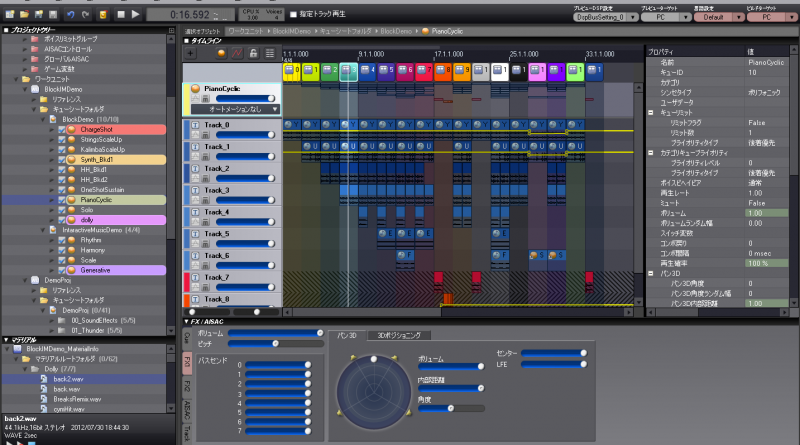Learning about Cue types
When using ADX2, almost every sound you will play will be triggered by a Cue (we say “almost” because the programmer could also play a waveform in memory or on disk directly). The type of the Cue is primordial to the audio implementation as it determines how the sound will be played. In this post, we examine the different types of Cues, from “Polyphonic” to “Random no repeat” via the more exotic “Combo sequential”.
In ADX2, a Cue is composed of one or more Tracks (each potentially containing several Waveform Regions on a timeline). The Cue type defines how these Tracks will actually be played when the Cue is triggered.
The available Cue types are: “Polyphonic”, “Sequential”, “Shuffle”, “Random”, “Random no repeat, “Switch” and “Combo sequential”. By default, the type is set to “Polyphonic”, which means that all the Tracks will be played simultaneously. This is particularly useful to create ambiances or any sound effect composed of several parts or layers.

A Cue of the “Sequential” type will only play one Track at a time. Each time the Cue is triggered, the next Track will be played. You could you use it for a countdown for example. The order of the Tracks – i.e. which one is actually the next one to be played – can be simply based on their position in the Cue or come from a playlist.
Cues of type “Shuffle” will play a new Track each time they are triggered. It is similar to the sequential mode, except that the order in which the Tracks are played is random (i.e. ADX2 will make sure that all Tracks have been played once before playing them again).
The “Random” and “Random no repeat” types are very similar. They both will pick up the next Track to play randomly. However, the latter will make sure the same sound is not repeated twice in a row, which could sound awkward, for example if your character’s footstep makes the exact same sound several times. Each Track can be assigned a random weight. These weights can be entered directly or adjusted graphically by dragging the black lines seen below.

The “Switch” type allows ADX2 to select the Track to be played based on a game selector, which is great for interactive sound. To come back to the footstep example, you could play a different Track based on the type of material the player is walking on for example. You would create a Selector called “Material” and it would have Selector Labels such as “Concrete”,”Wood”,”Grass” etc…
Finally, the “Combo sequential” type adds options to the sequential type, such as playing the next Track only if the Cue has been re-triggered within a given period of time, and returning to the first Track if it was not. Aptly named, it simulates the behavior of a combo, for example in a fighting game.
As you can see, the Cue types allow for the creation of complex sonic behaviors in a very intuitive way. But it is only a beginning… Indeed, you can nest Cues into other Cues, loop parts of the Cues, divide them into blocks etc… to create truly amazing interactive sounds. With ADX2, the possibilities are endless!


